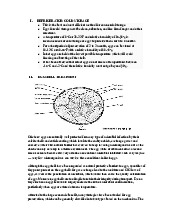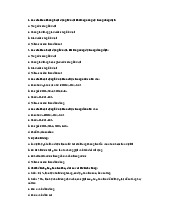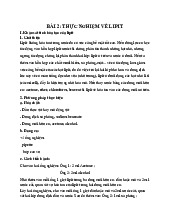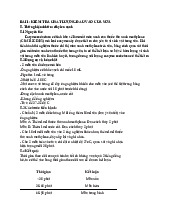










Preview text:
NONG LAM UNIVERSITY HO CHI MINH CITY
FACULTY OF CHEMICAL ENGINEERING AND FOOD TECHNOLOGY FOOD CHEMISTRY PRACTICA COURSE
Lecturer : DR. NGUYEN MINH XUAN HONG
Department of Food Biochemistry and Human Nutrition
Student’s full name: …………………………………………………………………
Student ID: ……………………………………………………………………………… 2024-2025 TABLE OF CONTENT
CHAPTER 1: GENERAL INTRODUCTION 1
CHAPTER 2: PRACTICAL LESSONS 2 LESSON 1: PREPARATION 3 1. 3 2. 4 3. 8 LESSON 2: GLUCID 3 1. 3 2. 4 3. 8 LESSON 3: LIPID 9 1. 9 2. 10 3. 11 LESSON 4: PROTEIN 12 1. 12 2. 13 3. 14 LESSON 5: FOOD COLOR 17 1. 17 2. 18 CHAPTER 3: CONCLUSIONS 20 REFERENCES 2 Lab Reports
The lab reports should contain abstract, background, materials and methods, results, and
discussion sections. All sections should be written with complete sentences in paragraph
form. Below are descriptions of what should be included in each section. The
contribution of each section to the grade for an individual lab report is given in
parentheses beside the section name.
Chapter 1: Introduction (5%) 5-10 sentences introducing about the course and the
lessons you studied in the course.
Chapter 2: Practical lessons. In each lesson, the report must contain the followings: -
Abstract (5%) – 4-6 sentences summarizing the goal of the experiment, the
techniques used, the findings and their relevance. -
Background (10%) – 1-2 paragraphs describing why you are doing the particular
experiment and providing the context to understand the results. Write this as if you
are explaining the experiment to an educated colleague whom has never been
exposed to that particular procedure. -
Materials and Methods (10%) – 1-2 paragraphs describing the techniques and
procedures used in the particular experiment. Use complete sentences, and write
out equations as necessary. If an equation is included, please give an example of a
calculation using the equation where you use real numbers. -
Results (25%) – 1-2 paragraphs describing your observations. Any tables and
figures reported in this section must include legends that describe the information
contained in the table or figure and how you interpret the data reported therein. -
Discussion (30%) – 2-3 paragraphs describing your interpretations of the results
of the experiment. Explain what the results mean and what you conclude from
them. Be sure to explain your reasoning for drawing your particular conclusions. -
Conclusion (5%) – 4-6 sentences summarizing the finding from the lesson.
Chapter 3: Conclusion (5%) – 5-10 sentences summarizing the finding from the
practica course with some further recommendations. References (5%)
Lab report must be written individually, printed and submitted within 2 weeks since the
last day of practical class. They need to be submited together by the class
representative at room 212A Cam Tu building. 3
Lab 1: LABORATORY SAFETY AND PREPARATION 1. Laboratory Safety
Safety is of paramount importance in this (or any) laboratory. Additional Safety Notes
are included in each of the experiments in this manual. In addition, laboratory instructor
will give specific guidelines on the safe conduct of each experiment at the beginning of
the labotatory period. Non-attendance during this safety briefing can result in students
being barred from participation in the laboratory experiment.
The following comments on the general rules as listed may help to clairfy any questions
that arise. Please inquire of your instructor of the lab manager if there are futher questions. -
Working without supervision is forbidden. A student should never stay in the
laboratory alone or work without a instructor present. -
Performing unauthorized experiments or any experiment at unauthorized times is
forbidden. Unanticipated results to an unauthorized or altered experiment can be
quite hazardous. Materials should never be taken from the laboratory. Horseplay and
panks are never acceptable in the laboratory. -
Approved safety eyewear must be worn when needed. Consult your instructor about
the policy for wearing contact lenses in your laboratory. Students may wear lenses,
but should infrom the instructor, so that should an accident occur, the instructor is
awear that the lenses are in your eyes. Certain solvents in use during some
experiment can have adverse effects on soft contacts and students should take
appropriate precautions following those labs. -
Loose hair and clothing must be restrained. Hair or clothing that can get caught or
otherwise be a hazard in lab should be pulled back. -
Appropriate attire must be worn in lab, icluding shoes that cover the entire foot, and
clothing which covers the legs and torso -
Eating, drinking, smoking, chewing tobacco and applying cosmetics are strictly forbidden in the laboratory. -
Items such as book bags, backpacks, purses and coats should be put out of way off
the floor and lab bench on one of the hooks provided. -
Cell phones should be turned off before entering the laboratory. 4 -
All accidents and breakage must be reported to an instructor. Any accident requires
attention to clean up. Alert your neighbors immediately if there is a spill as to its
nature and extent before you leave the area. -
Pipetting by mouth suction is forbidden. Pipet bulbs and/or dial-up pipetters will be provided when necessary. -
When needed, gloves must be worn. Gloves should be of a material and thickness
appropriate for the reagents being used. However, gloves provide only a temporary
layer of protection against chemicals on your skin and may be permeable to some
chemical reagents, without visible deterioration. If your gloves come in contact with
a chemical reagent, remove them, wash your hands, and get a new pair immediately. -
Read labels and dispose of any waste in an appropriate waste container. Ask
questions if you are not sure what to do. -
All materials used in the laboratory have a Material Safety Data Sheet (MSDS) on
file. If you wish to see one at any time, inquire the lab manager. -
Clean up in the laboratory is essential. Make sure you wash and put away all
equipment before you leave the laboratory. -
Hands must be washed just before leaving the laboratory. -
Inform your instructor at the beginning of the term if you have any special medical
conditions that may need attention during the laboratory, such as known allergies, seizures.
2. Laboratory preparation
- Preparation of glassware (test tubes, flasks, beakers, pipettes, …) and other equipment for each group
- Preparation of buffers, solvent and other chemicals Report: -
Figure out the safety aspect of the Food Biochemistry lab that you need to take care -
Make a list of necessary equipment and chemicals for this course -
How to prepare buffers and solvent 5 Lab 2: GLUCID
2.1. Ability of glucid in keeping food moisture
Aim: Examine the ability of keeping food moisture of different types of glucid. Material and equipment: -
Material: fruit, sorbitol, saccharose - Dryer Process:
Cut the fruit into pieces (~ 3x3 cm), weigh exactly amount of each fruit sample (~5g)
Divide fruit pieces into 3 parts:
Part 1: soak in 50% saccharose solution over
night Part 2: soak in 50% sorbitol solution
over night Part 3: store in the fridge over night
Moisture content measurement and sensory evaluation of those three
samples. Record and discuss about the results. Sample Texture Moisture content 13% 1. soak in saccharose 2. soak in sorbitol 16,16% 3. store in the fridge 7,7%
2.2. Gel-forming and stabilizer ability of polysaccharide
Aim: Examine the ability of forming gel of polysaccharide and their gel property. Material and equipment: -
Material: carboxymethyl cellulose (CMC), carrageenan, alginate, xanthan gum, guargum, pectin 6 - Test tube, beaker Process: -
Make 10mL of 1.5%, 3% and 4.5% of xanthan gum in water. Observe the texture of gel. -
Make 10mL of 2% pectin + 10% / 20% / 30% saccharose. Observe and
discussion about the effect of sugar concentration to the texture of gel. -
Make 10mL of 2% of each polysaccharide fruit juice (pineapple and
carrot). Observe and discussion about the stability of the suspension. 7 Lab 5: PIGMENT 5.1. Pigment of meat
Aim: Examine the color change of myoglobin. Material and equipment: - Material: pork, KNO2 - Oven, metal disks Process: -
Slide pork, divide them into 4 parts and put them into 4 metal disks.
Disk 1: Let it at room temperature in 2 hours
Disk 2: Let it at room temperature in 2 hours and boil it
Disk 3: Mixed with KNO2 and let it at room temperature in 2 hours
Disk 4: Mixed with KNO2 in 2 hours and boil it -
Observe the color and discuss the result.
5.2. Extraction of plant pigment
Aim: Examine the solubility of natural plant pigment. Material and equipment: -
Material: annatto seed, bicarbonat sodium, oil, 1N NaOH, 5% acid citric - Oven, beakers Process: -
Put 2g of annatto seed into 5 beakers. Then add as the following: Beaker 1: 10 mL water
Beaker 2: 10 mL 5% acid citric (or acetic acid) Beaker 3: 10 mL 1N NaOH
Beaker 4: 10 mL water + 1g Bicarbonat sodium
Beaker 5: 10 mL oil and heated -
Observe the color and discuss the result. 1



